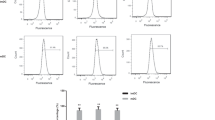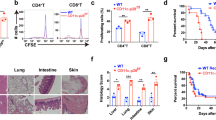Abstract
Immature dendritic cells (imDCs) are activated and mature to initiate an adaptive immune response, resulting in allograft rejection and transplantation failure. Myeloid differentiation factor 88 (Myd88) is a key factor in the Toll-like receptor (TLR) signaling pathway. Here, we investigated the effect of Myd88 silencing on DC function and immune response. CD34 + cells were isolated from the bone marrow of rhesus monkeys by the immunomagnetic bead method and then infected with an adenovirus expressing Myd88-specific short hairpin RNA (sh-Myd88). sh-NC (nontargeting negative control)- or sh-Myd88-infected DCs were treated with lipopolysaccharide (LPS) for another 48 h to induce DCS maturation. The maturation of DCs was identified by immunofluorescence staining for MHCII, CD80, and CD86. DC apoptosis was examined using Annexin V/PI staining. DC-related cytokine levels (IFN-γ and IL-12) were assessed by ELISA. A mixed lymphocyte reaction (MLR) was performed to test the effect of Myd88-silenced DCs on T lymphocytes in vitro. The results showed that compared with control or sh-NC-infected DCs, Myd88-silenced DCs had lower MHCII, CD80, CD86, and DC-related cytokine (IFN-γ and IL-12) levels. Myd88 did not affect the apoptosis of DCs. MLR demonstrated that Myd88 silencing could effectively block LPS-activated T cell proliferation in vitro. These data were consistent with the characteristics of tolerogenic DCs. In conclusion, our data indicated that Myd88 silencing could inhibit the maturation of imDCs and alleviate immune rejection, which provides a reference for immune tolerance in clinical liver transplantation.




Similar content being viewed by others
References
Alegre M-L, Chong A (2009) Toll-like receptors (TLRs) in transplantation. Front Biosci (elite Ed) 1:36
Blednov YA, Black M, Chernis J, Da Costa A, Mayfield J, Harris RA (2017) Ethanol consumption in mice lacking CD14, TLR2, TLR4, or MyD88. Alcohol Clin Exp Res 41:516–530
Boldyreva O, Burenkov G, Toropova L (2010) A new approach to the evaluation of the state of the microcirculatory system in patients presenting with chronic atrophic pharyngitis and treated with a synthetic neuropeptide. Vestn Otorinolaringol 18–19
Brunet M, Shipkova M, Van Gelder T, Wieland E, Sommerer C, Budde K, Haufroid V, Christians U, López-Hoyos M, Barten MJ (2016) Barcelona consensus on biomarker-based immunosuppressive drugs management in solid organ transplantation. Ther Drug Monit 38:S1–S20
Bugeon L, Dallman MJ (2000) Costimulation of T cells. Am J Respir Crit Care Med 162:S164–S168
Chen Y, Chen J, Liu Z, Liang S, Luan X, Long F, Peng Y, Yan L, Gong J (2008) Relationship between TH1/TH2 cytokines and immune tolerance in liver transplantation in rats. Elsevier, Transplantation Proceedings
Chen Y, Luk KD, Cheung KM, Lu WW, An XM, Ng SS, Lin MC, Kung HF (2004) Combination of adeno-associated virus and adenovirus vectors expressing bone morphogenetic protein-2 produces enhanced osteogenic activity in immunocompetent rats. Biochem Biophys Res Commun 317:675–681
Crowther C, Mowa B, Arbuthnot P (2016) Hepatic delivery of artificial micro RNAs using helper-dependent adenoviral vectors. Springer, SiRNA Delivery Methods
Dai C, Sun L, Yu L, Zhu G, Wu S, Bao W (2016) Effects of porcine MyD88 knockdown on the expression of TLR4 pathway-related genes and proinflammatory cytokines. Biosci Rep 36
Encabo A, Solves P, Carbonell-Uberos F, Miñana MD (2007) The functional immaturity of dendritic cells can be relevant to increased tolerance associated with cord blood transplantation. Transfusion 47:272–279
Gonzalez-Nieto L, Domingues A, Ricciardi M, Gutman MJ, Maxwell HS, Pedreño-Lopez N, Bailey V, Magnani DM, Martins MA (2016) Analysis of simian immunodeficiency virus-specific CD8+ T-cells in rhesus macaques by peptide-MHC-I tetramer staining. J Vis Exp e54881
Gu P, Gao JF, D’souza CA, Kowalczyk A, Chou K-Y, Zhang L (2012) Trogocytosis of CD80 and CD86 by induced regulatory T cells. Cell Mol Immunol 9:136–146
Huang C, Pan L, Lin F, Dai H, Fu R (2017) Monoclonal antibody against Toll-like receptor 4 attenuates ventilator-induced lung injury in rats by inhibiting MyD88-and NF-κB-dependent signaling. Int J Mol Med 39:693–700
Jiang ZK, Johnson M, Moughon DL, Kuo J, Sato M, Wu L (2013) Rapamycin enhances adenovirus-mediated cancer imaging and therapy in pre-immunized murine hosts. PLoS One 8
Kong F, Ye B, Lin L, Cai X, Huang W, Huang Z (2016) Atorvastatin suppresses NLRP3 inflammasome activation via TLR4/MyD88/NF-κB signaling in PMA-stimulated THP-1 monocytes. Biomed Pharmacother 82:167–172
Li B, Tian L, Diao Y, Li X, Zhao L, Wang X (2014) Exogenous IL-10 induces corneal transplantation immune tolerance by a mechanism associated with the altered Th1/Th2 cytokine ratio and the increased expression of TGF-β. Mol Med Rep 9:2245–2250
Li C, Ding L, Sun C-W, Wu L-C, Zhou D, Pawlik KM, Khodadadi-Jamayran A, Westin E, Goldman FD, Townes TM (2016) Novel HDAd/EBV reprogramming vector and highly efficient Ad/CRISPR-Cas sickle cell disease gene correction. Sci Rep 6:1–10
Liu G, Zhang L, Zhao Y (2010) Modulation of immune responses through direct activation of Toll-like receptors to T cells. Clin Exp Immunol 160:168–175
Oellerich M, Walson PD, Beck J, Schmitz J, Kollmar O, Schütz E (2016) Graft-derived cell-free DNA as a marker of transplant graft injury. Ther Drug Monit 38:S75–S79
Remuzzi G (2010) Transplant tolerance: progress and challenges. J Nephrol 23:263–270
Wu HL, Wiseman RW, Hughes CM, Webb GM, Abdulhaqq SA, Bimber BN, Hammond KB, Reed JS, Gao L, Burwitz BJ (2018) The role of MHC-E in T cell immunity is conserved among humans, rhesus macaques, and cynomolgus macaques. J Immunol 200:49–60
Wu Y, Yu Z, Gong J, Li M, Liu Y, Gong J (2017) Effects of combined genes of CTLA4Ig and IDO in post-liver transplantation immune tolerance of rats. Ann Hepatol 15:729–737
Xu H, Chen T, Wang H, Ji M, Zhu X, Wu W (2006) Prolongation of rat intestinal allograft survival by administration of donor interleukin-12 p35-silenced bone marrow–derived dendritic cells. Elsevier, Transplantation proceedings
Yang D-F, Qiu W-H, Zhu H-F, Lei P, Wen X, Dai H, Zhou W, Shen G-X (2008) CTLA4-Ig-modified dendritic cells inhibit lymphocyte-mediated alloimmune responses and prolong the islet graft survival in mice. Transpl Immunol 19:197–201
Yang R, Murillo FM, Cui H, Blosser R, Uematsu S, Takeda K, Akira S, Viscidi RP, Roden RB (2004) Papillomavirus-like particles stimulate murine bone marrow-derived dendritic cells to produce alpha interferon and Th1 immune responses via MyD88. J Virol 78:11152–11160
Zhang X, Beduhn M, Zheng X, Lian D, Chen D, Li R, Siu L, Marleau A, French P, Ichim T (2012) Induction of alloimmune tolerance in heart transplantation through gene silencing of TLR adaptors. Am J Transplant 12:2675–2688
Zheng C, Chen J, Chu F, Zhu J, Jin T (2020) Inflammatory role of TLR-MyD88 signaling in multiple sclerosis. Front Mol Neurosci 12:314
Acknowledgements
We thank the Central Cell Laboratory of Kunming Institute of Zoology, Chinese Academy of Science for cell culture work.
Funding
This study was supported by the National Natural Science Foundation of China (No. 81160069), Yunnan Provincial Science and Technology (No. 2018FE001-170), Applied Basic Research Foundation of Yunnan Province (No. 2016FB133), and National Natural Science Foundation of China (No. 81860124).
Author information
Authors and Affiliations
Contributions
All authors contributed to the study conception and design. Peng Chen and Mingdao Hu designed the study. Material preparation, data collection, and analysis were performed by Qiuhong Wang, Dongyun Cun, Desong Xu, Liang Lin, Jian Jiao, Li Zhang, Cheng Xi, and Wei Li. The first draft of the manuscript was written by Qiuhong Wang and Dongyun Cun. All authors commented on previous versions of the manuscript. All authors read and approved the final manuscript.
Corresponding authors
Ethics declarations
Ethics approval
Not applicable.
Consent to participate
Not applicable.
Consent for publication
Not applicable.
Conflict of interest
The authors declare no competing interests.
Additional information
Publisher's Note
Springer Nature remains neutral with regard to jurisdictional claims in published maps and institutional affiliations.
Rights and permissions
About this article
Cite this article
Wang, Q., Cun, D., Xu, D. et al. Myd88 knockdown with RNA interference induces in vitro immune hyporesponsiveness in dendritic cells from rhesus monkeys. Immunogenetics 74, 303–312 (2022). https://doi.org/10.1007/s00251-022-01260-x
Received:
Accepted:
Published:
Issue Date:
DOI: https://doi.org/10.1007/s00251-022-01260-x




